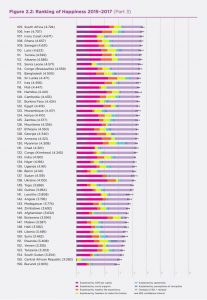Finland declared happiest country sixth time in a row
Finland has maintained its position as the country with the happiest population for the sixth year in a row.
At 75, Pakistan is way above India, and so is China (86). While Bangladesh and Sri Lanka are at 115 and 116 positions, respectively, Nepal stands at 101 and Bhutan at 97.

India's rank was 123 in the World Happiness report 2017. (Photo: Getty Images)
The latest World Happiness Report 2018 may not cheer up India. The country has slipped 10 ranks – from 123 to 133 – since last year. Finland tops the list of 156 countries ranked, pushing last year’s winner Norway to second position.
The World Happiness Report is a survey of the state of global happiness. The 2018 report ranks 156 countries by their happiness levels, and 117 countries by the happiness of their immigrants. The main focus of this year’s report, in addition to its usual ranking of the levels and changes in happiness around the world, is on migration within and between countries.
At 75, Pakistan is way above India, and so is China (86). While Bangladesh and Sri Lanka are at 115 and 116 positions, respectively, Nepal stands at 101 and Bhutan at 97.
Advertisement
According to the executive summary of the report, edited by John F Helliwell, Richard Layard and Jeffrey D Sachs, the overall rankings are based on the pooled results from Gallup World Poll surveys from 2015-2017, and show both change and stability.
Even though Finland has emerged as the new top ranking country, the countries on the top ten positions have remained same in the last two years, though some swapping of places has taken place. Denmark, Switzerland, Norway and now Finland have held the top spot in the four most recent reports.
The United States ranks 18th, four spots down since last year.

All the top countries tend to have high values for all six of the key variables that have been found to support well-being: income, healthy life expectancy, social support, freedom, trust and generosity. Among the top countries, differences are small enough that that year-to-year changes in the rankings are to be expected.
The analysis of happiness changes from 2008-2010 to 2015-2015 shows Togo as the biggest gainer, moving up 17 places in the overall rankings from the last place position it held as recently as in the 2015 rankings. The biggest loser is Venezuela, down 2.2 points on the 0 to 10 scale. India ranks 128 on this list. In this section, the report has considered how life evaluations have changed. While the previous reports considered changes from the beginning of the Gallup World Poll until the three most recent years, this report uses 2008-2010 as the base period, excluding all observations prior to the 2007 economic crisis. The figures show the changes in happiness levels for 141 countries “that have sufficient numbers of observations for both 2008-2010 and 2015-2017”.
Five of the report’s seven chapters deal primarily with migration. For both domestic and international migrants, the report studies not just the happiness of the migrants and their host communities, but also of those left behind, whether in the countryside or in the source country. The results are generally positive.
The ranking of countries according to the happiness of their immigrant populations is almost exactly the same as for the rest of the population – a fact that the editors say in the most striking finding of the report. The immigrant happiness rankings are based on the full span of Gallup data from 2005 to 2017, which had 117 countries with more than 100 immigrant respondents.
The ten happiest countries in the overall rankings also fill ten of the top eleven spots in the ranking of immigrant happiness. Finland is at the top of both rankings, with the happiest immigrants, and the happiest population in general.
“The closeness of the two rankings shows that the happiness of immigrants depends predominantly on the quality of life where they now live, illustrating a general pattern of convergence. Happiness can change, and does change, according to the quality of the society in which people live. Immigrant happiness, like that of the locally born, depends on a range of features of the social fabric, extending far beyond the higher incomes traditionally thought to inspire and reward migration. The countries with the happiest immigrants are not the richest countries, but instead the countries with a more balanced set of social and institutional supports for better lives,” says the report.
While convergence to local happiness levels is quite rapid, the editors say, it is not complete as there is a ‘footprint’ effect based on the happiness in each source country. This effect ranges from 10% to 25%. This footprint effect explains why immigrant happiness is less than that of the locals in the happiest countries, while being greater in the least happy countries.
Malawi, Liberia, Haiti, Syria, Rwanda, Yemen, Tanzania, South Sudan, Central African Republic and Burundi are the least happy countries, as per the report. It is for the second year in a row that Burundi and Central African Republic, both hit by political violence, are in the bottom two.
The report ends on a cautious note, listing the factors that can threaten happiness. It points to three emerging health problems — obesity, the opioid crisis, and depression.
Advertisement